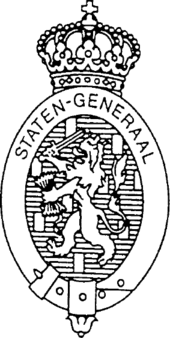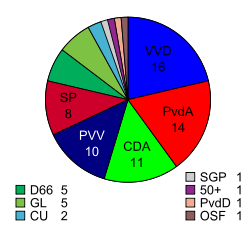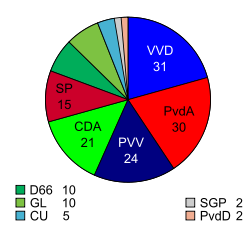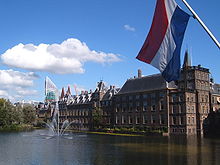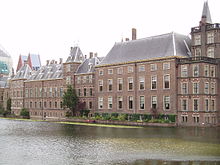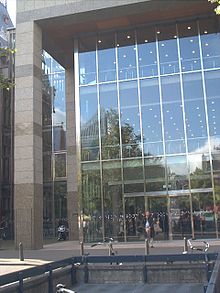- States-General of the Netherlands
-
The States-General of the Netherlands is the bicameral legislature of the Netherlands, consisting of the Senate and the House of Representatives. The parliament meets in at the Binnenhof in The Hague. The archaic Dutch word "staten" originally related to the feudal classes ("estates") in which medieval European societies were stratified (the clergy, the nobility and the commons). As in the United Kingdom the meaning of "the Commons" widened from just the social class, to the assembly in which those were represented; so in Dutch "staten" became to mean the political body in which the respective classes were (more or less) united. Dutch explorers named several places "Staten Island", a name that derives from the name of the parliament.
Contents
Functions
The States-General meets in joint session at least once a year, at the opening of the parliamentary year, when the queen gives her Speech from the Throne on Day of the Princelings. On special occasions, such as when the States-General vote on a marriage of a member of the royal house, when a king is inaugurated or when a member of the royal house dies, both houses also meet in a joint session (Dutch: Verenigde Vergadering), with the President of the Senate presiding. They take place in the Ridderzaal (Hall of Knights) in the Binnenhof, except for the inauguration of the monarch, which occurs in the Nieuwe Kerk in Amsterdam. The rest of the time, the two chambers sit separately.
Constitutionally, all functions of the parliament are given to both houses, except for the rights of initiative and amendment. In practice, however, the House of Representatives has these functions[clarification needed], as the Senate meets only one day a week. The Joint Session also appoints the monarch if there is no heir to the throne and the regent is unable to exercise his or her powers.
An important question is whether the relationship between cabinet and parliament should be dualistic or monistic. That is, whether ministers and leaders of governing parliamentary parties should prepare important political decisions. According to the dualistic position, members of parliament of governing parties should remain independent of the cabinet. The term 'monism' is used to refer to a stance that important decisions should be prepared by the people of the governing coalition in order to promote political stability.
History
Historically, the convocation of the States-General consisted of delegates from the States-Provincial, and dated from about the middle of the 15th century, under the rule of the Dukes of Burgundy. The first session was on January 9, 1464, in Bruges in Flanders at the behest of Philip III, Duke of Burgundy. Later, regular sessions were held at Coudenberg, Brussels (Brabant). After the abjuration of the king in 1581 and the separation of the northern Netherlands from the Spanish dominions, the States-General replaced the king as the supreme authority and as the central government of the northern Netherlands, which then became known as the United Provinces. Regional government was taken on by the States-Provincial. The representatives, now in The Hague (Holland), were elected as the general government of the United Provinces by the seven sovereign States-Provincial. The States-General, in which the voting was by province, each of the seven provinces having one vote, were established from 1593. Twenty per cent of the new Republic's territory, known as the Generality Lands, was not assigned to any provincial council and so was under the direct rule of the Generality (generaliteit). As such, this territory had no vote in the States-General. The Dutch East India Company and the Dutch West India Company were also under its general supervision; Staten Island in New York City (originally New Amsterdam) and Staten Island, Argentina (Discovered by Dutchman Jacob le Maire), are among places named after the Staten-Generaal.
The Southern Netherlands kept their own States-General in Brussels.
The States-General in both The Hague and Brussels came to an end after 1795; the South was annexed by France, and the North saw the proclamation of the Batavian Republic and the subsequent convocation of the National Assembly (1 March 1796). The title of Staten-Generaal, however, continued in the title of subsequent Dutch parliaments reconstituted in 1814, after the end of Napoleonic rule. There was one chamber until 1815, and two thereafter.
They were defunct from 1940–1945, during the German occupation.
Derivation of geographical names
In 1609, Henry Hudson established Dutch trade in Staten Island, New York City and named the island Staaten Eylandt after the Staten-Generaal.
The Argentine island Isla de los Estados was also named after this institution, the Spanish name being a translation of the Dutch.
Abel Tasman originally gave the name Staten Landt to what would become New Zealand.
References
 This article incorporates text from a publication now in the public domain: Chisholm, Hugh, ed (1911). Encyclopædia Britannica (11th ed.). Cambridge University Press.
This article incorporates text from a publication now in the public domain: Chisholm, Hugh, ed (1911). Encyclopædia Britannica (11th ed.). Cambridge University Press.
External links
Parliament of Europe Sovereign
states- Albania
- Andorra
- Armenia
- Austria
- Azerbaijan
- Belarus
- Belgium
- Bosnia and Herzegovina
- Bulgaria
- Croatia
- Cyprus
- Czech Republic
- Denmark
- Estonia
- Finland
- France
- Georgia
- Germany
- Greece
- Hungary
- Iceland
- Ireland
- Italy
- Kazakhstan
- Latvia
- Liechtenstein
- Lithuania
- Luxembourg
- Macedonia
- Malta
- Moldova
- Monaco
- Montenegro
- Netherlands
- Norway
- Poland
- Portugal
- Romania
- Russia
- San Marino
- Serbia
- Slovakia
- Slovenia
- Spain
- Sweden
- Switzerland
- Turkey
- Ukraine
- United Kingdom
- (England
- Northern Ireland
- Scotland
- Wales)
States with limited
recognition- Abkhazia
- Kosovo
- Nagorno-Karabakh
- Northern Cyprus
- South Ossetia
- Transnistria
Dependencies
and other territories- Åland
- Faroe Islands
- Gibraltar
- Guernsey
- Jan Mayen
- Jersey
- Isle of Man
- Svalbard
Other entities - European Union
Categories:- States-General of the Netherlands
- Parliaments by country
- Burgundian Circle
- Seventeen Provinces
- Dutch Republic
- Bicameral legislatures
- National legislatures
Wikimedia Foundation. 2010.

